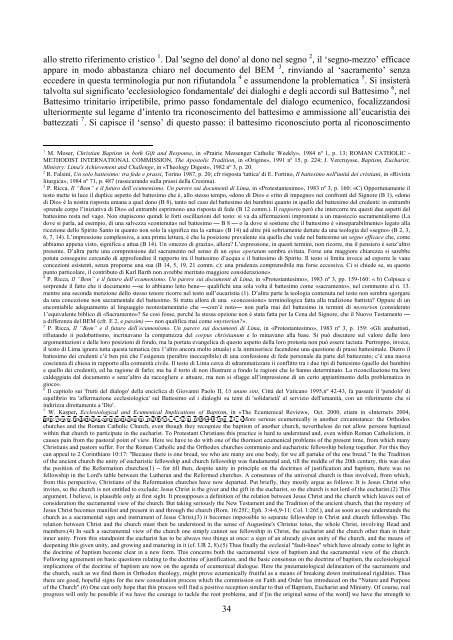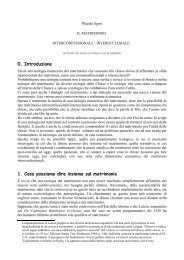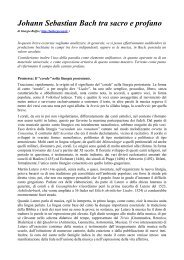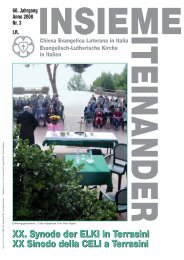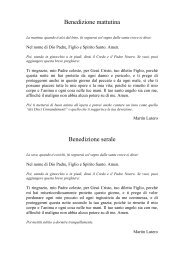Il dialogo ecumenico e interreligioso: quale futuro? - Nemesistemi
Il dialogo ecumenico e interreligioso: quale futuro? - Nemesistemi
Il dialogo ecumenico e interreligioso: quale futuro? - Nemesistemi
You also want an ePaper? Increase the reach of your titles
YUMPU automatically turns print PDFs into web optimized ePapers that Google loves.
allo stretto riferimento cristico 1 . Dal 'segno del dono' al dono nel segno 2 , il segno-mezzo efficace<br />
appare in modo abbastanza chiaro nel documento del BEM 3 , rinviando al sacramento senza<br />
eccedere in questa terminologia pur non rifiutandola 4 e assumendone la problematica 5 . Si insisterà<br />
talvolta sul significato 'ecclesiologico fondamentale' dei dialoghi e degli accordi sul Battesimo 6 , nel<br />
Battesimo trinitario irripetibile, primo passo fondamentale del <strong>dialogo</strong> <strong>ecumenico</strong>, focalizzandosi<br />
ulteriormente sul legame d intento tra riconoscimento del battesimo e ammissione all eucaristia dei<br />
battezzati 7 . Si capisce il senso di questo passo: il battesimo riconosciuto porta al riconoscimento<br />
1<br />
M. Moser, Christian Baptism in both Gift and Response, in «Prairie Messenger Catholic Weekly», 1984 nº 1, p. 13; ROMAN CATHOLIC -<br />
METHODIST INTERNATIONAL COMMISSION, The Apostolic Tradition, in «Origins», 1991 nº 15, p. 224; J. Vercruysse, Baptism, Eucharist,<br />
Ministry: Lima's Achievement and Challenge, in «Theology Digest», 1982 nº 3, p. 20.<br />
2<br />
R. Falsini, Un solo battesimo: tra fede e prassi, Torino 1987, p. 20; cfr risposta 'tattica' di E. Fortino, <strong>Il</strong> battesimo nell'unità dei cristiani, in «Rivista<br />
liturgica», 1984 nº 71, p. 487 (rassicurando sulla prassi della Cresima).<br />
3<br />
P. Ricca, <strong>Il</strong> Bem e il <strong>futuro</strong> dell ecumenismo. Un parere sui documenti di Lima, in «Protestantesimo», 1983 nº 3, p. 160: «C) Opportunamente il<br />
testo mette in luce il duplice aspetto del battesimo che è, allo stesso tempo, «dono di Dio» e «rito di impegno» nei confronti del Signore (B 1), «dono<br />
di Dio» è la nostra risposta umana a quel dono (B 8), tanto nel caso del battesimo dei bambini quanto in quello del battesimo del credenti: in entrambi<br />
«prende corpo l iniziativa di Dio» ed entrambi esprimono una risposta di fede (B 12 comm.). <strong>Il</strong> rapporto però che intercorre tra questi due aspetti del<br />
battesimo resta nel vago. Non stupiscono quindi le forti oscillazioni del testo: si va da affermazioni improntate a un massiccio sacramentalismo (La<br />
dove si parla, ad esempio, di una salvezza «contenuta» nel battesimo<br />
B 8<br />
34<br />
o la dove si sostiene che il battesimo è «inseparabilmente» legato alla<br />
ricezione dello Spirito Santo in quanto non solo la significa ma la «attua» (B 14) ad altre più sobriamente dettate da una teologia del «segno» (B 2, 3,<br />
6, 7, 14). L impressione complessiva, a una prima lettura, è che la posizione prevalente sia quella che vede nel battesimo un segno efficace che, come<br />
abbiamo appena visto, significa e attua (B 14). Un «mezzo di grazia», allora? L espressione, in questi termini, non ricorre, ma il pensiero è senz altro<br />
presente. D altra parte una comprensione del sacramento nel senso di un opus operatum sembra evitata. Forse una maggiore chiarezza si sarebbe<br />
potuta conseguire cercando di approfondire il rapporto tra il battesimo d acqua e il battesimo di Spirito. <strong>Il</strong> testo si limita invece ad esporre le vane<br />
concezioni esistenti, senza proporne una sua (B 14, 5, 19, 21 comm. c): una prudenza comprensibile ma forse eccessiva. Ci si chiede se, su questo<br />
punto particolare, il contributo di Karl Barth non avrebbe meritato maggiore considerazione».<br />
4<br />
P. Ricca, <strong>Il</strong> Bem e il <strong>futuro</strong> dell ecumenismo. Un parere sui documenti di Lima, in «Protestantesimo», 1983 nº 3, pp. 159-160: « b) Colpisce e<br />
sorprende il fatto che ii documento se lo abbiamo letto bene qualifichi una sola volta il battesimo come «sacramento», nel commento al n. 13.<br />
mentre una seconda menzione dello stesso tenore ricorre nel testo sull eucaristia (1). D altra parte la teologia contenuta nel testo non sembra sgorgare<br />
da una concezione non sacramentale del battesimo. Si tratta allora di una «concessione» terminologica fatta alla tradizione battista? Oppure di un<br />
encomiabile adeguamento al linguaggio neotestamentario che com è noto<br />
non parla mai del battesimo in termini di mysterion (considerato<br />
1 equivalente biblico di «Sacramento»? Se cosi fosse, perché Ia stessa opzione non è stata fatta per Ia Cena del Signore, che il Nuovo Testamento<br />
a differenza del BEM (cfr. E 2, e passim) - non qualifica mai come «nysterion?».<br />
5 P. Ricca, <strong>Il</strong> Bem e il <strong>futuro</strong> dell ecumenismo. Un parere sui documenti di Lima, in «Protestantesimo», 1983 nº 3, p. 159: «Gli anabattisti,<br />
rifiutando ii pedobattismo, incrinavano la compattezza del corpus christianum e lo minavano alla base. Si può discutere sul valore delle loro<br />
argomentazioni e delle loro posizioni di fondo, ma la portata evangelica di questo aspetto della loro protesta non può essere taciuta. Purtroppo, invece,<br />
il testo di Lima ignora tutta questa tematica (tra 1 altro ancora molto attuale) e la immiserisce facendone una questione di prassi battesimale. Dietro il<br />
battesimo dei credenti c è ben più che l esigenza (peraltro ineccepibile) di una confessione di fede personale da parte del battezzato; c è una nuova<br />
coscienza di chiesa in rapporto alla comunità civile. <strong>Il</strong> testo di Lima cerca di sdrammatizzare ii conflitto tra i due tipi di battesimo (quello dei bambini<br />
e quello dei credenti), ed ha ragione di farlo; ma ha il torto di non illustrare a fondo le ragioni che lo hanno determinato. La riconciliazione tra loro<br />
caldeggiata dal documento e senz altro da raccogliere e attuare, ma non si sfugge all impressione di un certo appiattimento della problematica in<br />
gioco».<br />
6 <strong>Il</strong> capitolo sui 'frutti del <strong>dialogo</strong>' della enciclica di Giovanni Paolo II, Ut unum sint, Città del Vaticano 1995,nº 42-43, fa passare il 'pendolo' di<br />
equilibrio tra 'affermazione ecclesiologica' sul Battesimo ed i dialoghi su temi di 'solidarietà' al servizio dell'umanità, con un riferimento che si<br />
indirizza direttamente a 'Dio'.<br />
7 W. Kasper, Ecclesiological and Ecumenical Implications of Baptism, in «The Ecumenical Review», Oct. 2000, etiam in «Internet» 2004,<br />
http://www.findarticles.com/p/articles/mi_m2065/is_4_52/ai_68864487/pg_23: «More serious ecumenically is another circumstance: the Orthodox<br />
churches and the Roman Catholic Church, even though they recognize the baptism of another church, nevertheless do not allow persons baptized<br />
within that church to participate in the eucharist. To Protestant Christians this practice is hard to understand and, even within Roman Catholicism, it<br />
causes pain from the pastoral point of view. Here we have to do with one of the thorniest ecumenical problems of the present time, from which many<br />
Christians and pastors suffer. For the Roman Catholic and the Orthodox churches communio and eucharistic fellowship belong together. For this they<br />
can appeal to 2 Corinthians 10:17: "Because there is one bread, we who are many are one body, for we all partake of the one bread." In the Tradition<br />
of the ancient church the unity of eucharistic fellowship and church fellowship was fundamental and, till the middle of the 20th century, this was also<br />
the position of the Reformation churches(1) -- for till then, despite unity in principle on the doctrines of justification and baptism, there was no<br />
fellowship in the Lord's table between the Lutheran and the Reformed churches. A consensus of the universal church is thus involved, from which,<br />
from this perspective, Christians of the Reformation churches have now departed. Put briefly, they mostly argue as follows: It is Jesus Christ who<br />
invites, so the church is not entitled to exclude; Jesus Christ is the giver and the gift in the eucharist, so the church is not lord of the eucharist.(2) This<br />
argument, I believe, is plausible only at first sight. It presupposes a definition of the relation between Jesus Christ and the church which leaves out of<br />
consideration the sacramental view of the church. But taking seriously the New Testament and the Tradition of the ancient church, that the mystery of<br />
Jesus Christ becomes manifest and present in and through the church (Rom. 16:25f.; Eph. 3:4-6,9-11; Col. 1:26f.), and as soon as one understands the<br />
church as a sacramental sign and instrument of Jesus Christ,(3) it becomes impossible to separate fellowship in Christ and church fellowship. The<br />
relation between Christ and the church must then be understood in the sense of Augustine's Christus totus, the whole Christ, involving Head and<br />
members.(4) In such a sacramental view of the church one simply cannot see fellowship in Christ, the eucharist and the church other than in their<br />
inner unity. From this standpoint the eucharist has to be always two things at once: a sign of an already given unity of the church, and the means of<br />
deepening this given unity, and growing and maturing in it (cf. UR 2, 8).(5) Thus finally the ecclesial "fault-lines" which have already come to light in<br />
the doctrine of baptism become clear in a new form. This concerns both the sacramental view of baptism and the sacramental view of the church.<br />
Following agreement on basic questions relating to the doctrine of justification, and the basic consensus on the doctrine of baptism, the ecclesiological<br />
implications of the doctrine of baptism are now on the agenda of ecumenical dialogue. Here the pneumatological delineation of the sacraments and<br />
the church, such as we find them in Orthodox theology, might prove ecumenically fruitful as a means of breaking down institutional rigidities. Thus<br />
there are good, hopeful signs for the new consultation process which the commission on Faith and Order has introduced on the "Nature and Purpose<br />
of the Church".(6) One can only hope that this process will find a positive reception similar to that of Baptism, Eucharist and Ministry. Of course, real<br />
progress will only be possible if we have the courage to tackle the root problems, and if [in the original sense of the word] we have the strength to


